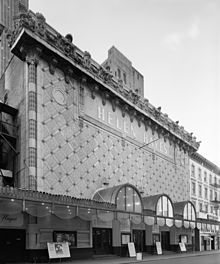List of Broadway theaters
The development of indoor gas lighting around this same time period allowed for the construction of permanent spaces for these novel theatrical forms.
[8] Mary Henderson in her book The City and the Theatre breaks down theater on the street Broadway into three time periods.
Variety, burlesque, minstrelsy halls, vaudeville, opera houses, hippodromes, and theaters all laid claim to the moniker.
The theaters are organized into four lists based on when their last theatrical production opened compared to the three moments that may be considered the beginning of Broadway theatre.
This new union contract laid out a legal division between Broadway and the newly defined Off-Broadway theaters.
[64] The following list notes the 34 theaters that housed Broadway productions after this strike ended but closed before the 1949 Actors' Equity agreement.
[118][117] The following list notes the 30 theaters that housed Broadway productions after The Black Crook opened but closed before the 1919 Actors' Equity strike.
[148] While most early theaters were short-lived and housed touring productions from Europe, that changed with the construction of the Park Theatre in 1798.
[1] These newly constructed, long-term theaters grew in number through the nineteenth century, clustered around Broadway, and began hosting a wide array of ethnic and new forms of entertainment.




